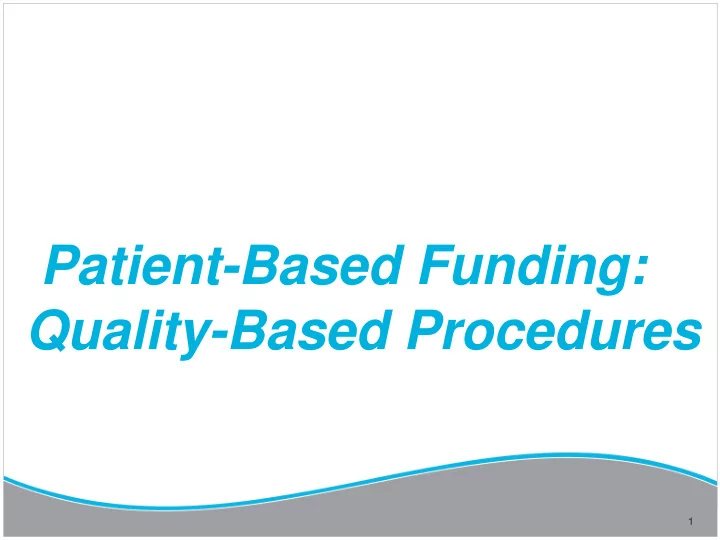

Patient-Based Funding: Quality-Based Procedures 1
Key Objectives • Discuss Rationale • Discuss Qbp’s and Key Features • Discuss quality improvement /alignment with funding • Describe Activity Based Costing • Next steps /Future state 2
Rationale for Change • Today, health care consumes 42 cents of every tax dollar. Without a change of course, health spending would eat up 70 per cent of the provincial budget within 12 years • The current financial scenario is unsustainable • Our population structure is changing. We’re living longer and as we age, the more we depend on our health care system. This isn’t the only reason costs are increasing. We now have more and better drugs available to prevent and treat disease, and there is a rise in the rate of chronic disease such as diabetes and high blood pressure. Ministry of Health and Long-Term Care, (n.d.). Excellent Care for All – Health System Funding Reform Retrieved from 3 http://www.health.gov.on.ca/en/ms/ecfa/pro/initiatives/funding.aspx
What are Quality-Based Procedures? • Groups of services for specific types of patients that require similar care • They present opportunities for health care providers to share best practices that will allow the system to achieve even better quality and system efficiencies. • Reimburse health care providers for the types and quantities of patients hospitals treat. • Funding is allocated to specific procedures based on a “price x volume” basis. 4
What are Quality-Based Procedures? In 2012, Quality-Based Procedures Will include: • Total hip replacement • Total knee replacement • Chronic kidney disease services • Cataract surgery • Other quality-based procedures will be added over time. ( Refer to Appendix A for interim Qbp list) 5
Qbp-Key Features • A key feature of QBP funding is to promote cost efficiency through a “set price”. • For 2012/13, the “set price” for any of the 6 QBPs is the 40th percentile of costs incurred on average over a three-year timeframe by all Ontario hospitals providing the procedure • Through time and further evolution of HSFR,the “set price” will be replaced by the “best price,” which will more explicitly reflect quality of care considerations 6
How will quality be improved with the introduction of QBP’s? • Quality of care provided will be improved through the adoption of evidence-informed best practices and clinical process redesign to streamline the delivery of care and improve patients ‟ experience and outcomes. • This will lead to a reduction in variability and greater consistency across the sectors. It will also support information sharing that will drive further improvements. • An evidence-based framework has been developed to support the identification of Quality Based Procedures. 7
Framework for Selecting Quality-Based Procedures Ministry of Health and Long-Term Care, (April, 2012). Health System Funding Reform Overview. 8
How are quality and funding aligned? • Patient-Based Funding and implementation of QBPs uses an evidence-informed approach to reimburse hospitals for every patient discharged at rates established for groups of cases with similar clinical profiles and resource requirements. • Funding is allocated to specific procedures based on a “price x volume” basis. • This approach will reimburse health care providers for the types and quantities of patients hospitals treat, using evidence- informed rates that are adjusted for patient complexity and quality of care delivered. 9
Funding 2012-14 Ministry of Health and Long-Term Care, (n.d.). Patient-Based Funding Overview Retrieved from 10 http://www.health.gov.on.ca/en/ms/ecfa/pro/docs/ecfa_funding_pres.pdf
Mitigation Strategies (Hospitals) • Mitigation corridors for HBAM and QBPs are applied to smooth out the impact: • Final corridors determined during Year 1 • Year 2 & 3 to be evaluated Ministry of Health and Long-Term Care, (April, 2012). Health System Funding Reform Overview. 11
Activity-Based Funding Funding hospitals on the basis of the type and volume of services they provide has become the international norm. Known as activity-based funding (ABF), these systems have been systematically supplementing global budgets in public and private insurance-based health systems around the world. ABF: Provides powerful financial incentives to stimulate productivity and efficiency: efficient hospitals retain the difference between the payment amount and the hospital’s actual cost of production. • Is associated with higher volumes of hospital care, shorter lengths of stay, and yet has not been linked to poorer quality of care. • Is linked to higher overall spending, due to higher volumes of patients being treated, and evidence of lower cost per admission is mixed. Canadian Health Services Research (2011) Hospital Payment Mechanisms: An Overview and Options for Canada . Retrieved 12 from http://www.chsrf.ca/Libraries/Hospital_Funding_docs/CHSRF-Sutherland-HospitalFundingENG.sflb.ashx
Next Steps: Funding Reform will require focus on Integration and Volume Management Integration will be a vital element of local health system change, and could include clinical services as well as administrative or support services MOH Action Taken • Quality based Procedures will integrate future funding across care types (ie. Acute hip procedure and community base rehab). LHIN Opportunity • Leverage opportunities to strengthen integration across service providers and health sectors. • Identify what will be needed to drive future integration opportunities? • Volume planning and management will be critical over the coming years (eg. CSR, siting of procedures, etc.) 13
Future State: Will the 40th percentile strategy be the approach for QBPs in the future? • The 40th percentile has only been used to set prices for three of the four groupings in 2012/2013 QBPs, which reflect relatively homogenous groupings (i.e. Chronic Kidney Disease was set at estimates based on data provided by the Ontario Renal Network). • In the coming months, expert panels will develop best practice patient clinical pathways for each QBP and set consensus- based, evidence-informed prices for each QBP. 14
How has acuity been factored into the pricing strategy? The „direct cost per weighted case‟ approach is based on • adjustments used nationally to account for additional resources for each patient group, (HIG) as identified by diagnoses, co- morbidities and to some extent complications. • Further work is underway to reach consensus on the impact of acuity on setting an evidence-informed price for each QBP. 15
Appendix A: QBPs 2013-15 – Draft 16
Recommend
More recommend